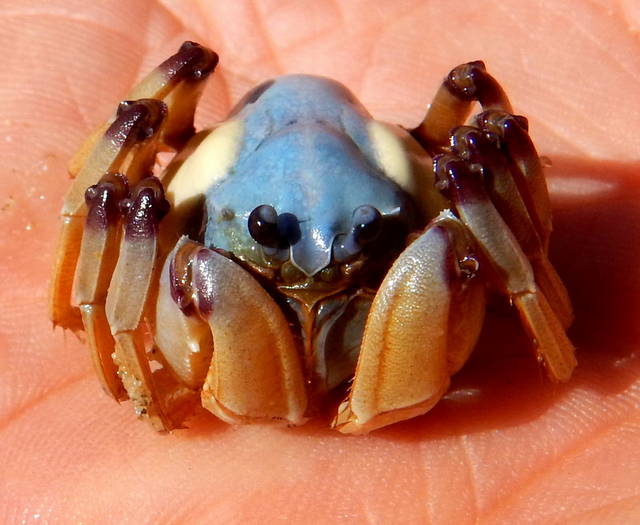Published in the Ocean Watch column, Honolulu Star-Advertiser © Susan Scott
June 10, 2017
BREAKWATER MARINA, TOWNSVILLE, AUSTRALIA >> For the last three years, as often as our work allows, Craig and I have been sailing our 37-foot ketch, Honu, in the stretch of water between the Queensland coast and Australia’s Great Barrier Reef Marine Park.
Before I came here, I would have guessed that sailing back and forth in the same area, year after year, might get old. But here, never. The reef’s 1,400-mile length is about the same distance as Kure Atoll is from the Big Island. And the distance from the Australian mainland to the park’s 3,000 reefs and 600 islands ranges from 20 to 155 miles, gaps similar to those between Oahu and neighbor islands.
 A soldier crab is among several varieties of crabs found
A soldier crab is among several varieties of crabs found
in and around the Whitsunday Islands in Australia.
©2017 Susan Scott
Given this expanse, plus changes in seasons, tides, storms and wildlife, each trip — even to repeat places — seems entirely new.
This year Cyclone Debbie, a category-4 storm that struck the central area about two months ago, changed both the landscape and reefs of many of the Whitsunday Islands.
As we landed our dinghy at Whitehaven, a 4-mile-long beach made of powderlike silica, a material that doesn’t retain heat, we stood shocked. The majestic trees that had lined the beach now lay in tangles of trunks and branches, their bark releasing tannin in streams that rippled through the white sand with the changing tides.
The beach was still glorious, however, and we walked its length, watching birds peck at exposed worms and snails, and enjoying the firm silica squeaking beneath our feet. The national park service had already pushed back fallen trees, and cleared a trail that looped through the wrecked woods.
Hiking there became a highlight of the trip.
Inside that broken forest, endless tiny leaves sprouted from trunks, branches, air roots and soil, a stunning picture of nature’s resilience. Craig chose that bright green growth in a devastated forest as his favorite moment of the trip.
I cheated in picking my favorite, because I named a whole category of creatures: crabs. Due to persistent strong, chilly winds, we often hunkered down in anchorages, and walked on tidal flats for hours on end.
Australia’s crabs performed brilliantly. Blue-and-white soldier crabs marched in legions of thousands, and tiny sand bubbler crabs left their sand-ball art in acres of designs. When caught out, 3-inch-wide swimming crabs turned to fight us, raising their tiny claws in defiance. En guard, monsters!
I saw spider crabs, seaweed crabs and a brown crab that jumped into a muddy tide pool to hide but kept us in sight (adorably) with its tall, white eyestalks.
On Monday I’ll be back on Oahu. I’m torn between wanting to stay in Australia and longing to get back to Hawaii. How lucky I am to travel back and forth between two of the best places on Earth.